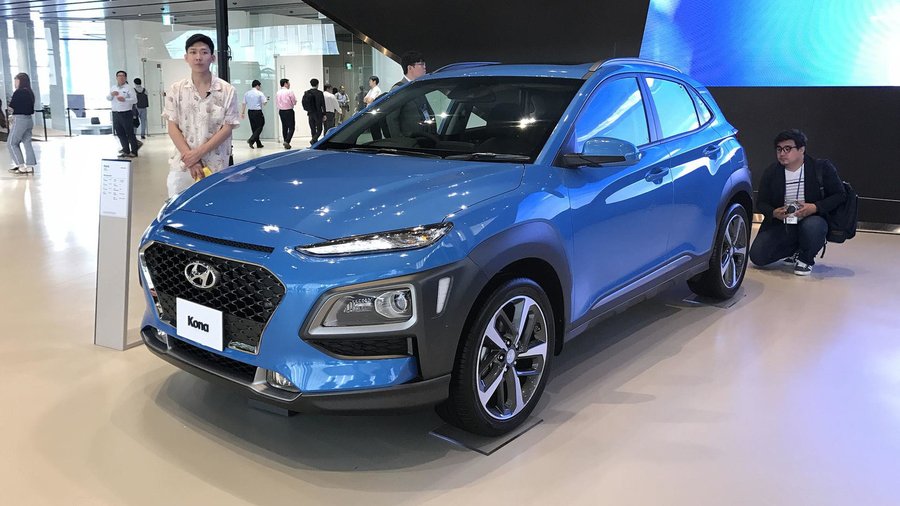The Kona enters one of the hottest segments on the market and will compete straight against Honda HR-V, Toyota C-HR, and Fiat 500X. The stylish Kona slots below the larger Santa Fe and Tucson, filling out the Hyundai's crossover offerings. The new model goes on sale in Korea later this month, hitting showrooms in Europe and the US later this year.
Like others in this segment, the Kona sells itself on style as well as substance. The design is more aggressive than Hyundai's other crossover offerings, though the automaker says it hints at a new direction for other products. After a few years of conservative design throughout its lineup, Hyundai has returned to the bold direction that kicked off with the sleek 2010 Sonata.
The Kona's large, shield-like grille is similar to that on the new Elantra GT and refreshed Sonata. There's a wide air scoop just above the new grille. There's a lot of outside influence on the design. The rest of the body has a taut, masculine look. Big fenders and sharp creases carry on the rugged look. Hyundai is calling the black cladding "armor," though we're not sure exactly how much it protects. It's going to be a divisive design choice for sure. Like the Toyota C-HR, the Kona can be had with a contrasting roof color.
The Kona makes use of LED lighting both front and rear, though the low placed headlights remind us of the controversial ones on the Jeep Cherokee. The taillights are wide, slim units that aren't like anything else in Hyundai's lineup. Like so many compact crossovers, it looks more like a high-riding hatchback than a shrunken SUV. It's a handsome design though that's more tough than cute.
The interior has been designed with efficiency first. Hyundai boasts that the Kona has the best-in-class interior space. The simple layout is far more conservative than the exterior, but it appears well designed and well arranged. Like the Elantra GT, the infotainment screen sits above the dash like a tablet. It's a common design feature, though not always a popular one.
The Kona can be had with a 5, 7, or 8-inch infotainment display, though availability depends on the market. Higher-spec models come with Apple CarPlay, Android Auto, HD and satellite radio, a rearview camera, and in the US, 4G telematics. The Kona will have wireless smartphone charging. It will also come with a heads-up display, a feature more and more common on modern cars.
For many crossover shoppers, safety is paramount. The Kona uses high-strength steel to reduce weight and increase passive safety. As Hyundai loves to point out, it's the only automaker to make its own steel to produce its vehicles worldwide. The Kona will pack a whole host of active safety features, including forward-collision avoidance, lane-keep assist, automatic high beams, blind-spot monitoring, and rear cross-traffic alert.
The exhaust and all-wheel drive system have been fitted in way that minimizes interior intrusion. Out back, the suspension has been designed to allow a low load floor and lower rear seats, helping both interior space and headroom. The rear seats fold flat while the rear cargo area has two height settings.
The Kona will use a variety of engines, though only two are likely to make it to the US. The first is a 2.0-liter inline four making about 147 horsepower. It will be mounted to a six-speed automatic transmission and is good for 0-62 mph in about 10 seconds. Not exactly screaming, but average for the class. The engine runs on the efficient Atkinson cycle, which should help boost a yet-to-be rated fuel economy.
The upgraded powertrain is Hyundai's turbocharged 1.6-liter inline-four and 7-speed dual-clutch combo. With a total of 175 horsepower and 195 lb-ft of torque, the duo will move the Kona from 0-62 mph in 7.7 seconds, genuinely quick for the class. Europe will have the choice of a 1.0-liter turbo three-cylinder engine or a 1.6-liter diesel.
Like nearly everything in the class, the Kona will have an optional all-wheel drive system. Hyundai hasn't said if it will be available with every engine. While the Kona uses a McPherson strut system up front, the rear suspension understandably differs depending on the all-wheel drive system. The front-wheel drive models get a torsion beam out back while all-wheel drive models get a dual-arm multi-link setup.
Final pricing, fuel economy ratings, and an on-sale date haven't been finalized, though details should be revealed in the next few months.

